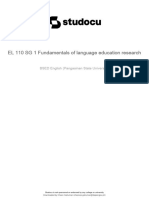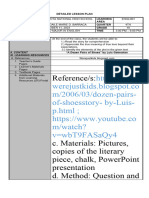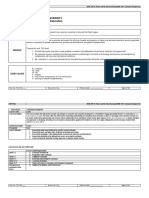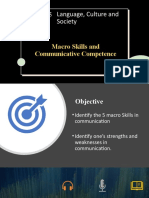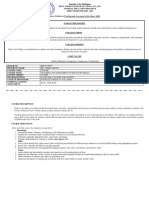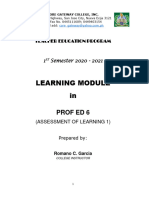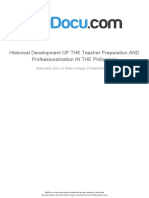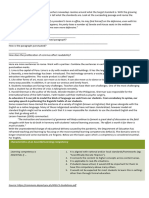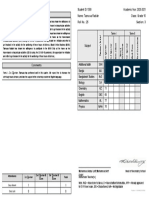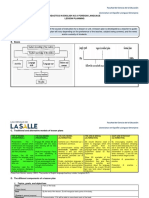Ricky C. Alfon: - Individual Differences - (Prof Ed 6) Facilitating Learner-Centered Teaching
Ricky C. Alfon: - Individual Differences - (Prof Ed 6) Facilitating Learner-Centered Teaching
Uploaded by
Mark Joseph DacubaCopyright:
Available Formats
Ricky C. Alfon: - Individual Differences - (Prof Ed 6) Facilitating Learner-Centered Teaching
Ricky C. Alfon: - Individual Differences - (Prof Ed 6) Facilitating Learner-Centered Teaching
Uploaded by
Mark Joseph DacubaOriginal Description:
Original Title
Copyright
Available Formats
Share this document
Did you find this document useful?
Is this content inappropriate?
Copyright:
Available Formats
Ricky C. Alfon: - Individual Differences - (Prof Ed 6) Facilitating Learner-Centered Teaching
Ricky C. Alfon: - Individual Differences - (Prof Ed 6) Facilitating Learner-Centered Teaching
Uploaded by
Mark Joseph DacubaCopyright:
Available Formats
CARAMOAN COMMUNITY COLLEGE
Caramoan, Camarines Sur
1st SEMESTER SY 2021-2022
MODULE 4
-Individual Differences
- (Prof Ed 6) Facilitating Learner-Centered Teaching
RICKY C. ALFON
09551938779
rickyalfon8@gmail.com
ricky.alfon001@deped.gov.ph
Page | 0 (PROF ED 6) FACILITATING LEARNER-CENTERED TEACHING / MODULE 4
CARAMOAN COMMUNITY COLLEGE
Caramoan, Camarines Sur
FACILITATING LEARNER-CENTERED TEACHING
PROFESSIONAL EDUCATION 6 (PROF ED 6)
A. LEARNING TARGETS
At the end of this module, you will be able to do the following:
a) Identify the different factors that bring about diversity in the classroom
b) Demonstrate a positive attitude towards diversity as an enriching element
in the learning environment, and
c) Come up with teaching strategies that consider student diversity.
B. WARM UP
Before you proceed in this module, I challenge you to do the activity below.
Coordinate through short messaging service (text messaging) to at least five (5) of your
classmates. Let them answer the following survey.
Name:
Age:
Gender:
Nationality:
Province:
Language/Dialects Spoken:
Hobbies/Interests:
Favorite Subjects:
Subjects you are best in:
Subjects you find Difficult:
Ambition:
Tally your responses to come up with a consolidated profile.
Let us analyze what you have gathered.
1. In what ways you and your classmates similar?
2. In what ways you and your classmates different?
.
3. How does a girl differ from a boy in behavior?
4. In what ways does a Korean differ to you?
5. How does life in the province differ from that in a city?
6. Are you glad you have similarities? Differences?
Page | 1 (PROF ED 6) FACILITATING LEARNER-CENTERED TEACHING / MODULE 4
CARAMOAN COMMUNITY COLLEGE
Caramoan, Camarines Sur
7. How can the teacher utilize these similarities and differences in teaching?
C. OVERVIEW
You’ve probably heard some say, “Everyone is unique”. Though it sounds really like a
cliché, one cannot ignore the truth in it. As a facilitator of learning, the teacher is tasked to
consider the individual differences among the students in planning for effective instruction.
Analyze the data presented in a Graphic Organizer below.
Benefits of
Diversity in the
Classroom
Classroom
Individual
Strategies for
Differences
Student
Factors
Diversity
Individual
Differences
(Student
Diversity)
D. LESSON PROPER
In all learning environments, individuals interact with others who are in some way
different from them. Recall how these differences were shown in your gathered data –
gender, racial, ethnic or cultural backgrounds (nationality, province, language). This diversity
also comes from other factors like the following:
1. Socioeconomic status- Lifestyles of rich people differ from those of the poor
ones.
2. Thinking/Learning styles – Some of you learn better by seeing something,
others by just listening; and others by manipulating something. (You will learn
more of this in your later modules.)
Page | 2 (PROF ED 6) FACILITATING LEARNER-CENTERED TEACHING / MODULE 4
CARAMOAN COMMUNITY COLLEGE
Caramoan, Camarines Sur
3. Exceptionalities- In class there may be one who have difficulty in spoken
language comprehension or in seeing, hearing, etc.. We will have more of this in
Module 9.
How Student Diversity Enriches the Learning Environment?
A teacher may be challenged to handle a class with students so diverse. There may be
students having different cultural backgrounds, different language abilities, different attitudes
and aptitude and behaviors. Some teachers might see this diversity as difficult predicament,
really a hassle. Yet a more reflective teacher may see a diverse classroom as an exciting place
to learn not just or her students, but for herself as well. A wise teachers may choose to respect
and celebrate diversity. Read on to discover the benefits and learning opportunities that student
diversity can bring to your classroom.
1. Students’ self-awareness is enhanced by diversity.
Exposing students to others with diverse backgrounds and experiences also serves to help
students focus on their awareness of themselves. When they see how students focus on their
awareness of themselves. When they see how other are different, students are given reference
points or comparative perspectives which sharpen assessment of their own attitudes, values
and behaviors.
2. Student diversity contributes to cognitive development.
The opportunity to gain access to the perspectives of peers and to learn from other
students, rather than the instructor only, may be especially important for promoting the cognitive
development of the learners. According to Supreme Court Justice William J. Brennan “The
classroom is peculiarly the marketplace of ideas”. The depth and breadth of student learning are
enhanced by exposure to others from diverse backgrounds. Student diversity in the classroom
brings about different point of views and varied approaches to the learning process.
As the German philosopher Nietzsche said over a century ago; “The more affects we allow
to speak about one thing, the more eyes, different eyes we can use to observe one thing the
more complete will our concept of this thing, our objectivity be.”
3. Students diversity prepares learners for their role as responsible members of
society.
Suzanne Morse stresses one competency that has strong implications for instructional
strategies that capitalize on diversity: “The capacity to imagine situations or problems from all
perspectives and to appreciate all aspects of diversity’’. Furthermore, she argued: “ The
classroom can provide more than just theory given by the teacher in a lecture. With student
diversity, the classroom becomes a public place where community can be practiced.
4. Student diversity can promote harmony.
When student diversity is integrated into the classroom teaching and learning process, it can
become a vehicle in promoting harmonious race relations. Through student-centered
teaching strategies, diverse students can be encouraged to interact and collaborate with one
another, on learning tasks that emphasize unity of effort while capitalizing on their diversity
of backgrounds
Page | 3 (PROF ED 6) FACILITATING LEARNER-CENTERED TEACHING / MODULE 4
CARAMOAN COMMUNITY COLLEGE
Caramoan, Camarines Sur
Some TIPS on Student Diversity
1. Encourage learners to share their personal history and experiences.
Students will be made to realize that they have something in common with the rest. They
also differ in several ways.
2. Integrate learning experiences and activities which promote students’
multicultural and cross-cultural awareness.
You can encourage or even initiate co-curricular experiences that are aimed to
promoting diversity awareness. These activities could be held to coincide with already
scheduled national weeks or months which are designated for appreciation of diverse
groups. Example, Disability Awareness Week, Buwan ng Wika, Indigenous People’s
Week.
Let students interview other students on campus who are from diverse backgrounds.
These students of different racial and ethnic origin serve as source of firsthand
information on topics related to their culture. This can also provide opportunity for
interaction among students who may otherwise never come in contact with each other.
Invite students to Internet discussions group emails; have students watch a blog about
different counties and their cultures.
Ask students if they have ever been to personal target of prejudice or discrimination, and
have them share experiences with other members of the class.
3. Aside from highlighting diversity, identify patterns of unity that transcend group
differences.
Clyde Kluckholn, an early American anthropologist who spent a lifetime studying
human diversity across different cultures, concluded from his extensive research that,
“Every himan is, at the same time, like all other humans, like some humans, and like no
other human.” (cited in Wong, 1991). His observation suggest a paradox in the human
experience, namely: We are all the same in different ways.
It may be important to point out to students the biological reality that human beings
share approximately 95% of their genes in common, and less than 5% of our genes
account for the physical differences that exist among us. When focusing on human
differences, these commonalities should not be overlooked, otherwise, our repeated
attempts to promote students diversity may inadvertently promote student divisiveness.
One way to minimize this risk, and promote unity along with diversity, is to stress the
universality” of the learning experience by raising students’ consciousness of common
themes that bind all groups of people – in addition to highlighting the variations in those
themes.
Periodically place students in homogenous groups on the basis of shared
demographic characteristics ( e.g. same-gender groups or same-race/ethnicity
groups), and have them share their personal views or experiences with respect
to course issues. Then form a panel comprised of representatives from each
group who report their group’s ideas. You can serve as moderator and identify
the key differences and recurrent themes that emerge across different groups, or
students who are not on the panel can be assigned this tasks.
Try to form groups of students who are different with respect to one demographic
characteristics but similar with respect to another (e.g., similar gender but different in
race/ethnicity, or similar in age but different gender). This practice can serve to increase
student awareness that humans who are members of different groups can, at the same
Page | 4 (PROF ED 6) FACILITATING LEARNER-CENTERED TEACHING / MODULE 4
CARAMOAN COMMUNITY COLLEGE
Caramoan, Camarines Sur
time, be members of the same group – and share similar experiences, needs or
concerns.
After students have completed self-assessment instruments (e.g. learning style
inventories or personality profiles), have them line up or move to a corner of the room
according to their individual scores or overall profile. This practice can visibly
demonstrate to students how members of different student populations can be quite
similar with respect to their learning styles or personality profiles, i.e. students can see
how individual similarities can often overshadow group differences.
4. Communicate high expectations to students from all sub-groups
Make conscious attempt call on, or draw in students from diverse groups by using
effective questioning techniques that reliably elicit student involvement. In addition to
consciously calling on them in class, other strategies for “drawing in” and involving
students include : a) assigning them the role of reporter in small-group discussions, i.e.,
the one who report backs the group’s ideas to the class, and b) having them engaged in
paired discussions with another classmate with the stipulation that each partner must
take turns assuming the role of both listener and speaker, and c) scheduling instructor-
student conference with them outside the classroom.
Learn the name of your students, especially the foreign names that you may have
difficulty pronouncing. This will enable you to establish early, personal rapport with them
which can later serve as a social/emotional foundation or springboard for encouraging
them to participate.
5. Use varied instructional methods to accommodate student diversity in learning
styles.
Diversify the sensory/perceptual modalities through which you deliver and present
information (e.g. in print, diagrammatic and pictorial representations, or “hands on”
experiences.
Diversify the instructional formats or procedures you use in class:
Use formats that are student-centered and teacher-centered.
Use formats that are unstructured (i.e. trial and error discovery learning)
and structured (e.g., step-by-step instruction)
Use procedures that involve both independent learning (i.e.,
independently completed simple projects) ;and interdependent learning
(i.e collaborative learning in pairs or small groups)
6. Vary the examples you use to illustrate concepts in order to provide multiple
contexts that are relevant to students from diverse backgrounds.
Specific strategies for providing multiple examples and varied contexts that are
relevant to their varied backgrounds include the following:
Have students complete personal information cards during the first week of class and
use this information to select examples or illustrations that are relevant to their personal
interests and life experiences.
Use ideas, comments, and questions that students raise in class, or which they choose
to write about to help you think of examples and illustrations to use.
Ask students to provide their own examples of concepts, based on experiences drawn
from their personal lives.
Have students apply concepts by placing them in situation or context that is relevant to
their lives (e.g., How would you show respect to all persons in you r home?).
Page | 5 (PROF ED 6) FACILITATING LEARNER-CENTERED TEACHING / MODULE 4
CARAMOAN COMMUNITY COLLEGE
Caramoan, Camarines Sur
7. Adapt to the student’s diverse backgrounds and learning styles by allowing them
personal choice and decision-making opportunities concerning what they will
learn and how they will learn it.
Giving the learner more decision-making opportunity with respect to learning
tasks; a) promotes positive student attitudes toward the subject matter, b) foster more
positive interactions among students, and c) results in students working more
consistently with lesser teacher intervention. Also, when individuals are allowed to exert
some control over a task, they tend to experience less anxiety or stress while performing
the task.
8. Diversify your methods of assessing and evaluating student learning.
You can accommodate student diversity not only by varying what you do with your
teaching, by also by varying what you ask your students to do to demonstrate learning.
In addition to the traditional paper-and-pencil tests and written assignments, students
can demonstrate their learning in a variety of other performance formats, such as a)
individually-delivered reports, b) panel presentations, c) group projects, d) visual
presentations (e.g., concept maps, slide presentations, collage, exhibits), or e) dramatic
vignettes – presented live or video-taped. On potential benefits of allowing students to
choose how they demonstrate their learning is that the variety of options exercised may
be powerful way to promote student awareness of the diversity of human learning styles.
9. Purposely, form small discussion groups of students from diverse backgrounds.
You can form groups of students with different learning styles, different cultural
backgrounds, etc..
Small peer-learning groups may be effective for promoting student progress to a more
advanced stage of cognitive development. Peer-learning groups may promote this
cognitive advancement because: a) the instructor is removed from center stage, thereby
reducing the likelihood that the teacher is perceived as the ultimate or absolute authority;
and b) students are exposed to the perspectives of other students, thus increasing their
appreciation of multiple viewpoints and different approaches to learning.
E. DO IT YOURSELF
a. Performance Task
Task 1:
Let us exercise you synapses. Think of a slogan that celebrates diversity in the classroom.
Make posters and have it posted in your class group chat.
Page | 6 (PROF ED 6) FACILITATING LEARNER-CENTERED TEACHING / MODULE 4
CARAMOAN COMMUNITY COLLEGE
Caramoan, Camarines Sur
Task 2:
Describe and present the concept on individual differences by means of the following:
(choose only one)
Song
Poem
Jingle
Slide Presentation
Powerpoint Presentation
Post it in our class group chat in messenger or in google classroom.
Task 3:
From the module on Individual Differences, I learned that
Congratulations! You completed this module!
F. REFERENCES
Facilitating Learning: A Metacognitive Process pages 41-50
Maria Rita D. Lucas, PhD
Brenda B. Corpuz, PhD
Page | 7 (PROF ED 6) FACILITATING LEARNER-CENTERED TEACHING / MODULE 4
You might also like
- Tp-Technical Drafting NC IiDocument6 pagesTp-Technical Drafting NC IiCris VidalNo ratings yet
- Classroom Assessment in Mathematics 2 PDFDocument249 pagesClassroom Assessment in Mathematics 2 PDFAnh Kiet Bui100% (1)
- Butuyan, Samantha Claire V (LEP Case Analysis)Document2 pagesButuyan, Samantha Claire V (LEP Case Analysis)Sam ButuyanNo ratings yet
- EL 107 Working ModuleDocument95 pagesEL 107 Working Modulecharlesbagtas8No ratings yet
- ENG 103 Midterm Reviewer - Structure of EnglishDocument6 pagesENG 103 Midterm Reviewer - Structure of EnglishCheldenNo ratings yet
- El 110 SG 1 Fundamentals of Language Education ResearchDocument11 pagesEl 110 SG 1 Fundamentals of Language Education ResearchMoo Ni KaNo ratings yet
- Chapter 3 - Remedial Teaching Strategies: Characteristics of Learning Among Pupils With Learning DifficultiesDocument7 pagesChapter 3 - Remedial Teaching Strategies: Characteristics of Learning Among Pupils With Learning DifficultiesChristoPher TorioNo ratings yet
- Plot of The Woman Who Had Two NavelsDocument14 pagesPlot of The Woman Who Had Two NavelsKate Ciara SalabsabinNo ratings yet
- Intended Learning Outcomes: India-Land of PrayerDocument24 pagesIntended Learning Outcomes: India-Land of PrayerJewo CanterasNo ratings yet
- Unit 1 - Authentic Assessment in The Classroom (GROUP 1A)Document13 pagesUnit 1 - Authentic Assessment in The Classroom (GROUP 1A)Princess Ann DomingoNo ratings yet
- EDUC 65:: Foundation of Special and Inclusive EducationDocument51 pagesEDUC 65:: Foundation of Special and Inclusive EducationZyrill MachaNo ratings yet
- Educ 104Document15 pagesEduc 104gds4tmz4pgNo ratings yet
- EngageDocument4 pagesEngageKian MellinaNo ratings yet
- ReportDocument52 pagesReportJessy Chris PajaronNo ratings yet
- Tangible Product: Report in Educ 11 A (Assessment Learning 2) Performance-Based TaskDocument5 pagesTangible Product: Report in Educ 11 A (Assessment Learning 2) Performance-Based TaskRhylet GorospeNo ratings yet
- Cognitive Development of The Infant and ToddlerDocument49 pagesCognitive Development of The Infant and ToddlerCrispo PrindianaNo ratings yet
- Internal Factors Are Basically Guided by The Attitude of An Individual. That IsDocument5 pagesInternal Factors Are Basically Guided by The Attitude of An Individual. That Isfaith nadresNo ratings yet
- DLP LiteratureDocument21 pagesDLP LiteraturebarracaabygailemarieNo ratings yet
- EL115 RitualismDocument14 pagesEL115 RitualismCasseopheia MarañoNo ratings yet
- DepEd Order 31 SDocument2 pagesDepEd Order 31 SMayraniel RuizolNo ratings yet
- ELE 204 - English For Specific Purposes (Notes)Document33 pagesELE 204 - English For Specific Purposes (Notes)Gene Bryan SupapoNo ratings yet
- DepEd No. 53 Series of 1987Document11 pagesDepEd No. 53 Series of 1987Mart Albert ReborteraNo ratings yet
- Oral Lore (Ho 3)Document2 pagesOral Lore (Ho 3)Donali Gem Manalang PableoNo ratings yet
- Policies and Issues On The Internet and Implications To Teaching and LearningDocument31 pagesPolicies and Issues On The Internet and Implications To Teaching and LearningCarla Jean NollanNo ratings yet
- DLP Philippine LitDocument9 pagesDLP Philippine Litcristinematinez24No ratings yet
- The Child and Adolescent LearnersDocument6 pagesThe Child and Adolescent LearnersChe Pueblo100% (1)
- EDUC-205-OBTL-The-Teacher-and-The-School-Curriculum (1) - 2Document10 pagesEDUC-205-OBTL-The-Teacher-and-The-School-Curriculum (1) - 2Richelle DadesNo ratings yet
- Eng 124 - Unit 2 L 4-6Document20 pagesEng 124 - Unit 2 L 4-6Elrose Saballero KimNo ratings yet
- Assessment: Direction: Read The Story of "Silence - A Fable" by Edgar Allan Poe. Interpret and Analyze The StoryDocument4 pagesAssessment: Direction: Read The Story of "Silence - A Fable" by Edgar Allan Poe. Interpret and Analyze The StoryElsa BorrinagaNo ratings yet
- Lesson 3:: Kicking It OffDocument3 pagesLesson 3:: Kicking It OffKevin BlasurcaNo ratings yet
- Module 3. REVIEWERDocument8 pagesModule 3. REVIEWERLeila Ricci LlanilloNo ratings yet
- Session 5 Language Culture and SocietyDocument15 pagesSession 5 Language Culture and SocietyRHEA MARIMLA100% (2)
- A Formalistic Analysis On Luis P. Gatmaitan's A Dozen Pair of Shoes - EJESDocument2 pagesA Formalistic Analysis On Luis P. Gatmaitan's A Dozen Pair of Shoes - EJESEllen Grace D. EjesNo ratings yet
- First Language Acquisition - A Case Study of A Three-Year Old Lebanese ChildDocument3 pagesFirst Language Acquisition - A Case Study of A Three-Year Old Lebanese ChildRudney Quinte Barlomento0% (1)
- Writing and Deconstruction of Classical TalesDocument7 pagesWriting and Deconstruction of Classical TalesArjie Maningcay ArcoNo ratings yet
- Deped Order 31, Series of 2012: Presented By: Arnold C. TeodoroDocument16 pagesDeped Order 31, Series of 2012: Presented By: Arnold C. TeodoroARNOLD TEODORONo ratings yet
- Course Syllabus in Teaching and Assessment of The Macro SkillsDocument13 pagesCourse Syllabus in Teaching and Assessment of The Macro SkillsLarrizze GallardoNo ratings yet
- Famous and Contemporary Approaches To Reading Literature: ExampleDocument3 pagesFamous and Contemporary Approaches To Reading Literature: ExampleMarkNo ratings yet
- Assessment in Learning 1Document50 pagesAssessment in Learning 1SJC ITRNo ratings yet
- TL of Language Culture and Society EXAMDocument3 pagesTL of Language Culture and Society EXAMFaith Lanie LumayagNo ratings yet
- ILAO MidtermsDocument2 pagesILAO MidtermsPrincess Fritz IlaoNo ratings yet
- Module 5Document14 pagesModule 5Justine Joy SabalboroNo ratings yet
- EL 109 - Group 9 - Written ReportDocument27 pagesEL 109 - Group 9 - Written ReportPrincess Apple PanganNo ratings yet
- Historical Development of The Teacher Preparation and Professionalization in The PhilippinesDocument3 pagesHistorical Development of The Teacher Preparation and Professionalization in The PhilippinesArianne Rose FangonNo ratings yet
- Story Book AnalysisDocument30 pagesStory Book AnalysisNurhanis KamaNo ratings yet
- Sinners in The Hand of Angry GodDocument4 pagesSinners in The Hand of Angry GodJoshua Nathaniel MondejarNo ratings yet
- Group 4 - HandoutDocument17 pagesGroup 4 - HandoutKyle Justin Rayos100% (1)
- AnnDocument6 pagesAnnRonnie PastranaNo ratings yet
- Stages of Literature Learning in The ClassroomDocument44 pagesStages of Literature Learning in The ClassroomDanielle Akutagawa100% (1)
- Historical Timeline of Noteworthy LinguistsDocument16 pagesHistorical Timeline of Noteworthy LinguistsJomaica Mae TamayoNo ratings yet
- Midterm On EL 112 1st Sem 20-21Document3 pagesMidterm On EL 112 1st Sem 20-21mascardo franzNo ratings yet
- Assessment of The Macroskills: Pre-Competency ChecklistDocument20 pagesAssessment of The Macroskills: Pre-Competency ChecklistsalditoskriiusyNo ratings yet
- The Lost GenerationDocument14 pagesThe Lost GenerationAngeline Guevarra Dela CruzNo ratings yet
- Ele 2 - 1st ModuleDocument9 pagesEle 2 - 1st ModuleJerrome Dollente JardinNo ratings yet
- The Language Policy of The Commission On Higher EducationDocument1 pageThe Language Policy of The Commission On Higher Educationjoy05.alexa.01No ratings yet
- MODULE - 1.1 Metacognition (Reflection Paper)Document2 pagesMODULE - 1.1 Metacognition (Reflection Paper)jasminNo ratings yet
- Evaluation of Supplementary Materials For English Language TeachingDocument19 pagesEvaluation of Supplementary Materials For English Language TeachingJm Dorado75% (4)
- Afro Asian DramaDocument14 pagesAfro Asian DramaAnonymous X916UK3y6No ratings yet
- THE RETURN-WPS OfficeDocument5 pagesTHE RETURN-WPS OfficeNailaNo ratings yet
- Aspects of The Standards Finals TopicDocument5 pagesAspects of The Standards Finals TopicRosemary Dawn FegideroNo ratings yet
- Issues and Trends in Teaching 21st Century LiteraciesDocument19 pagesIssues and Trends in Teaching 21st Century LiteraciesGracielle ValdezNo ratings yet
- A Brief History of Badminton from 1870 to 1949From EverandA Brief History of Badminton from 1870 to 1949Rating: 3.5 out of 5 stars3.5/5 (2)
- Course Description and Syllabus: Anatomy & Physiology - Springport High SchoolDocument4 pagesCourse Description and Syllabus: Anatomy & Physiology - Springport High SchoolChristopher Rey BurceNo ratings yet
- Sample Project RationaleDocument1 pageSample Project RationaleAbiNo ratings yet
- My Community and I 1 PDFDocument3 pagesMy Community and I 1 PDFAndrew Sebi MonsalesNo ratings yet
- Lesson PlanDocument3 pagesLesson Planapi-247662207No ratings yet
- Compare and Contrast Plan Courtney LesmanDocument4 pagesCompare and Contrast Plan Courtney Lesmanapi-290385244No ratings yet
- Analytical Report: Extra-Curricular Activities Name: Tasnuva Radiah Class: Grade 10 Section: 3 Roll No.: 25Document1 pageAnalytical Report: Extra-Curricular Activities Name: Tasnuva Radiah Class: Grade 10 Section: 3 Roll No.: 25Arif AsgarNo ratings yet
- Lesson Planning in ELTDocument7 pagesLesson Planning in ELTYamith J. FandiñoNo ratings yet
- English As An International LanguageDocument3 pagesEnglish As An International LanguageEdher QuintanarNo ratings yet
- HR Course File SummaryDocument5 pagesHR Course File SummaryWalid Mohamed AnwarNo ratings yet
- MODULE TOPIC 1 GEC 5 Art AppreciationDocument6 pagesMODULE TOPIC 1 GEC 5 Art AppreciationJayArt Amogis TemPoral100% (1)
- WIFA FormsDocument12 pagesWIFA FormsDoc Alex100% (1)
- Albert Einstein in School - by Ridham Garg Xi-FDocument14 pagesAlbert Einstein in School - by Ridham Garg Xi-FRidham GargNo ratings yet
- DLL Arts WK 2Document4 pagesDLL Arts WK 2Maricar SorianoNo ratings yet
- Lesson Plan in Science Ii PDFDocument5 pagesLesson Plan in Science Ii PDFCiel EvangelistaNo ratings yet
- Learning Environment InventoryDocument3 pagesLearning Environment Inventoryapi-426153804No ratings yet
- Relationships Between LINUS Teachers Knowledge of PDFDocument12 pagesRelationships Between LINUS Teachers Knowledge of PDFYayang NasrudinNo ratings yet
- ESP Lesson PlanDocument4 pagesESP Lesson PlanKevin Lee100% (1)
- Bab 3Document13 pagesBab 3Suci Alifkha DidinNo ratings yet
- Text and Context: Exploring Values of Character in "Al-Qiro'ah Al-Rosyidah" TextDocument37 pagesText and Context: Exploring Values of Character in "Al-Qiro'ah Al-Rosyidah" TextLuluNo ratings yet
- Functional Resumes For Experienced Professionals: Career Document SeriesDocument5 pagesFunctional Resumes For Experienced Professionals: Career Document Seriessujit5584No ratings yet
- Development and Evaluation of Module in Basic DressmakingDocument11 pagesDevelopment and Evaluation of Module in Basic DressmakingPsychology and Education: A Multidisciplinary JournalNo ratings yet
- At Goldman SachsDocument4 pagesAt Goldman SachsKalyan Sreenivas KandipatiNo ratings yet
- General Studies and Communication SkillsDocument276 pagesGeneral Studies and Communication Skillskubana friendNo ratings yet
- Program Outcomes POs of B. Sc. in CSE ProgramDocument1 pageProgram Outcomes POs of B. Sc. in CSE ProgramMohammed BhuyanNo ratings yet
- Projekt Ne AnglishtDocument4 pagesProjekt Ne AnglishtKeti PulakuNo ratings yet
- M.Sc. Statistics NEP Syllabus Wef 2022-23-1Document67 pagesM.Sc. Statistics NEP Syllabus Wef 2022-23-1Prashant SharmaNo ratings yet
- Zatu OGDocument5 pagesZatu OGFrendo MulexNo ratings yet
- Doodle Notes Quick Reference Fall 2018Document2 pagesDoodle Notes Quick Reference Fall 2018api-252888343100% (1)





